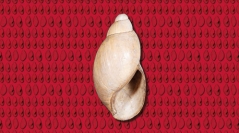

 Geodiversitas
45 (21) - Pages 643-657
Geodiversitas
45 (21) - Pages 643-657The genus Palaeoglandina Wenz, 1914 (Gastropoda: Stylommatophora: Spiraxidae) is a common member of land snail communities in the European Cenozoic. It has been reported from numerous stratigraphic horizons in the Iberian Peninsula ranging from the Middle Eocene (Lutetian) to the Early Pleistocene (Calabrian). Investigating Late Miocene to Early Pliocene communities in the Teruel Basin in eastern Spain, we found that previous species records proved to be misidentifications of a yet undescribed species. Based on a thorough review of contemporaneous European species of the genus we introduce a new species, Palaeoglandina turolensis n. sp. It is characterized by a large oval to fusiform, comparatively stout shell with moderately convex whorls, short spire and large last whorl, large, pyriform aperture, and a characteristic protoconch ornamentation, consisting of a deep spiral groove flanked by thick, short, prosocyrt riblets. We applied geometric morphometric analyses to assess the species’ morphological variability. Our results indicate differences in the species’ morphospace occupation through time, which we interpret as a morphological shift from the Late Miocene to the Early Pliocene, from broad, short-spired shells to slender, long-spired shells.
Terrestrial molluscs, Neogene, Teruel Basin, Iberian Peninsula, geometric morphometrics, Palaeoglandina, new species